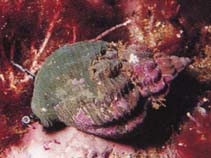| Family: |
Buccinidae (buccinum whelks) |
| Max. size: |
10.16 cm SHL (male/unsexed) |
| Environment: |
benthic; marine; depth range 0 - 600 m |
| Distribution: |
Arctic, Northern Atlantic and the Mediterranean: Canadian Arctic Archipelago and the Atlantic Ocean. Temperate to polar climates. |
| Diagnosis: |
Shell: not very thick, solid, conical spire, generally high, sometimes rather flattened spires, very convex whorls and markedly impressed suture; ovoidal aperture, outer lip is not thickened or toothed, lacks inner folds; columellar lip has a fairly striking callus, partly adheres to the ventral surface of the body whorl; sculpture has almost equidistant spiral grooves and quite big axial ribs that tend to fade at the edge of the body whorl and are generally sinous; yellowish white or light hazel in color; periostracum is light chestnut in color and not very resistant; operculum is horny, smaller than the aperture, has a central nucleus. Body: large foot, whole body cream with blackish patches; head has a pair of tentacles with an eye at the base of each, long proboscis; well-developed siphon; radula is rachnioglossan. |
| Biology: |
Maximum depth from Ref. 106864. Common in the continental shelf (Ref. 106864). Common in the subtidal to 200 m depth in the northern Atlantic (Ref. 78657). Usually found on hard bottoms (Ref. 95730), as well as soft bottoms from 5 to 600 m (Ref. 106864). Also found to occur in areas with sludge (Ref. 96352). Relatively sedentary (Ref. 106864). It is a necrophagous, scavenger species (Ref. 96498). Feeds on polychaetes, mollusks, echinoderms and other smaller crustaceans (Ref. 106864). Also found in mud, sand, gravel and rocks (Ref. 78654). |
| IUCN Red List Status: |
Not Evaluated (N.E.) Ref. 123251)
|
| Threat to humans: |
|
| Country info: |
|
Source and more info: www.sealifebase.org. For personal, classroom, and other internal use only. Not for publication.

